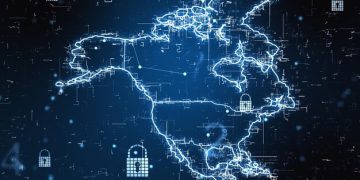US Cybersecurity Policy: Data Protection Under New Regulations

Navigating the evolving landscape of cybersecurity regulations in the U.S. is crucial for individuals and organizations alike to effectively protect sensitive data against emerging threats and ensure compliance with new governmental mandates.
In an increasingly interconnected world, where digital threats loom large, understanding the shifting sands of Cybersecurity Policy in the US: 4 Steps to Protect Your Data Under the New Regulations is no longer just for industry experts; it’s a fundamental necessity for everyone. As new regulations emerge and existing ones evolve, staying informed and proactive becomes paramount to safeguarding your digital assets and maintaining privacy.
Understanding the Current US Cybersecurity Landscape
The United States faces a complex and ever-changing cybersecurity landscape. This environment is characterized by the rapid evolution of cyber threats, from sophisticated nation-state attacks to pervasive ransomware campaigns and data breaches. Organizations, from small businesses to Fortune 500 companies, are constantly under siege, highlighting the urgent need for robust defense mechanisms and clear policy frameworks.
Federal agencies, in particular, are at the forefront of developing and implementing new regulations designed to bolster the nation’s digital resilience. These efforts often reflect a delicate balance between national security interests, economic competitiveness, and individual privacy rights. The goal is to create a secure digital ecosystem that fosters innovation while mitigating risks.
Key Regulatory Bodies and Their Roles
Several key governmental bodies play pivotal roles in shaping US cybersecurity policy. Their mandates often overlap, requiring significant coordination to ensure a cohesive national strategy. Each contributes a unique perspective and set of authorities.
- NIST (National Institute of Standards and Technology): Develops cybersecurity frameworks and guidelines that are widely adopted across industries. Their publications, like the Cybersecurity Framework, are voluntary but serve as foundational best practices.
- CISA (Cybersecurity and Infrastructure Security Agency): Acts as the nation’s risk advisor, working with public and private partners to defend critical infrastructure from cyber threats. CISA provides resources, guidance, and incident response support.
- OMB (Office of Management and Budget): Oversees the implementation of cybersecurity policies across federal agencies, ensuring compliance and effective risk management within government operations.
- DoD (Department of Defense): Focuses on protecting national defense systems and critical military networks, often pioneering advanced cybersecurity research and development initiatives.
Beyond these, sector-specific agencies like the Department of Health and Human Services (HHS) and the Securities and Exchange Commission (SEC) also impose cybersecurity requirements tailored to their respective industries, emphasizing compliance in areas like healthcare and financial services.
The current legislative environment seeks to close gaps identified in previous policies, driven by high-profile breaches and the increasing sophistication of cyber adversaries. This includes efforts to standardize reporting requirements, enhance information sharing between government and industry, and promote the adoption of advanced security measures. Understanding who is responsible for what helps demystify the regulatory labyrinth and clarifies expectations for compliance.
Step 1: Assess Your Current Data Protection Posture
Before implementing any new strategies, a thorough assessment of your existing data protection posture is essential. This initial step provides a baseline, identifying strengths, weaknesses, and potential vulnerabilities that new regulations might address or exacerbate. It’s akin to a health check-up for your digital infrastructure.
Begin by mapping your data. Understand what sensitive data you collect, where it resides, how it’s processed, and who has access to it. This data mapping exercise is crucial for establishing the scope of your compliance efforts. Without knowing what data you possess, protecting it becomes a nebulous and often ineffective endeavor.
Conducting a Comprehensive Risk Assessment
A risk assessment should not be a superficial exercise. It requires a deep dive into potential threats and their impact on your organization. This involves identifying specific cyber threats, such as ransomware, phishing, insider threats, and supply chain attacks, and evaluating their likelihood and potential consequences.
- Identify Critical Assets: Pinpoint the data, systems, and processes that are most vital to your operations and most attractive to attackers.
- Evaluate Existing Controls: Review the effectiveness of your current security measures, including firewalls, encryption, access controls, and employee training.
- Analyze Vulnerabilities: Look for gaps, misconfigurations, or weaknesses that could be exploited by threat actors. This often involves penetration testing and vulnerability scanning.
- Prioritize Risks: Rank identified risks based on their potential impact and likelihood, allowing you to allocate resources effectively to mitigate the most pressing concerns.
Once risks are identified and prioritized, develop a clear understanding of your organization’s risk appetite. This helps determine the appropriate level of investment in cybersecurity measures. Some risks may be accepted, others mitigated, transferred, or avoided altogether. The goal is not to eliminate all risk, which is often impossible, but to manage it to an acceptable level.
Regularly reviewing and updating your risk assessment is paramount. The threat landscape is dynamic, and what was considered low risk yesterday might be a critical vulnerability today. This iterative process ensures that your data protection strategies remain relevant and effective against evolving cyber challenges.
Step 2: Understand and Implement New Federal Regulations
The landscape of federal cybersecurity regulations is constantly shifting, driven by evolving threats and legislative priorities. Staying abreast of these changes and understanding their implications for your organization is a challenging yet critical task. These new regulations often impose more stringent requirements, expand reporting obligations, and demand greater accountability for data security.
One notable trend is the increasing focus on prescriptive measures rather than just general guidelines. Regulations are moving towards mandating specific security controls, data breach notification timelines, and even minimum security standards for critical infrastructure. This shift aims to reduce ambiguity and ensure a consistent level of protection across various sectors.

Key Recent and Emerging Regulations
While the specifics can vary greatly, several broad themes and regulations are central to the current federal push for enhanced cybersecurity. Understanding these broad strokes helps organizations anticipate and prepare for compliance requirements.
- Cyber Incident Reporting for Critical Infrastructure Act (CIRCIA): This act mandates critical infrastructure entities to report significant cyber incidents and ransomware payments to CISA within specific timeframes. It aims to improve federal visibility into cyber threats and facilitate coordinated responses.
- NIST Cybersecurity Framework 2.0 (CSF 2.0): While still voluntary, the updated CSF emphasizes governance, supply chain risk management, and continuous improvement, broadening its applicability beyond critical infrastructure to all organizations.
- State-Level Data Privacy Laws: Beyond federal mandates, states like California (CCPA/CPRA), Virginia (VCDPA), and Colorado (CPA) have enacted comprehensive data privacy laws that include significant cybersecurity components, impacting how businesses collect, use, and secure personal data.
- Sector-Specific Updates: Financial services (e.g., Gramm-Leach-Bliley Act), healthcare (HIPAA), and government contractors (e.g., CMMC for DoD contracts) continue to see updates to their sector-specific cybersecurity regulations, often increasing the rigor of required controls and audits.
Implementing these regulations effectively requires a systematic approach. Begin by conducting a gap analysis to identify where your current practices fall short of the new requirements. This often involves reviewing your existing policies, procedures, and technical controls against the detailed provisions of the regulation. Develop a clear remediation plan that outlines the steps needed to achieve compliance, assigns responsibilities, and sets realistic timelines.
Compliance is not a one-time event but an ongoing process. Regular monitoring, auditing, and updating of your security measures are crucial to maintain adherence as both threats and regulations evolve. Consider seeking legal counsel or cybersecurity experts to navigate particularly complex regulatory landscapes, ensuring your interpretation and implementation are accurate and robust.
Step 3: Fortify Your Digital Defenses
Once you’ve assessed your posture and understood the new regulatory requirements, the next crucial step is to actively fortify your digital defenses. This involves implementing robust security measures that go beyond mere compliance, aiming to build a resilient and adaptive cybersecurity ecosystem. It’s about proactive protection rather than reactive damage control.
Effective fortification touches upon multiple layers of your IT infrastructure, from network perimeters to individual endpoints and cloud environments. It integrates technology, processes, and people to create a cohesive defense strategy that can withstand various forms of cyber attacks.
Implementing Core Security Practices
Several foundational cybersecurity practices form the backbone of a strong defense. These are not novel concepts but their consistent and rigorous application is often the most significant differentiator in preventing breaches.
- Multi-Factor Authentication (MFA): Mandate MFA for all user accounts, especially those with access to sensitive data or critical systems. This significantly reduces the risk of unauthorized access due to compromised passwords.
- Strong Encryption: Encrypt data at rest and in transit. This protects sensitive information even if it falls into the wrong hands, rendering it unreadable without the proper decryption key.
- Regular Software Updates and Patch Management: Keep all operating systems, applications, and firmware updated. Cybercriminals frequently exploit known vulnerabilities in outdated software.
- Network Segmentation: Divide your network into isolated segments to limit the lateral movement of attackers within your systems if a breach occurs in one area.
- Endpoint Detection and Response (EDR)/Extended Detection and Response (XDR): Deploy advanced security solutions that can detect, analyze, and respond to threats across endpoints, networks, and cloud environments, offering deeper visibility than traditional antivirus.
Beyond technical controls, establishing a strong security culture within your organization is equally vital. Employees are often the first line of defense, and their awareness and adherence to security protocols can prevent many incidents. Conduct regular cybersecurity awareness training, simulate phishing attacks, and foster an environment where employees feel comfortable reporting suspicious activities without fear of reprisal.
Furthermore, consider adopting a “zero-trust” security model, where no user or device is inherently trusted, regardless of whether they are inside or outside the network perimeter. Every access request is verified, limiting the potential impact of a compromised account. This paradigm shift from perimeter-based security offers a more robust defense against modern threats.
Step 4: Establish Robust Incident Response and Recovery Plans
Even with the most fortified defenses, the reality is that a cyber incident is not a matter of “if,” but “when.” Therefore, establishing robust incident response and recovery plans is a critical fourth step. These plans are your roadmap for minimizing damage, restoring operations, and ensuring business continuity in the aftermath of a breach or security event.
An effective incident response plan details the procedures for detecting, analyzing, containing, eradicating, recovering from, and post-incident activity. It outlines roles, responsibilities, communication protocols, and escalation paths, ensuring a coordinated and efficient response when time is of the essence.

Key Components of an Incident Response Plan
A comprehensive incident response plan should be a living document, regularly reviewed and updated to reflect changes in your IT environment, threat landscape, and regulatory requirements. It should include:
- Preparation Phase: This involves developing the plan itself, forming an incident response team, acquiring necessary tools, and conducting regular training and exercises.
- Identification Phase: Defines how incidents are detected (e.g., through alerts from security tools, user reports) and how they are initially triaged and validated.
- Containment Phase: Outlines steps to stop the spread of an attack, such as isolating compromised systems, disabling accounts, and blocking malicious IP addresses.
- Eradication Phase: Focuses on removing the root cause of the incident and all remnants of the attack, like malware and backdoors.
- Recovery Phase: Details how systems and data are restored to normal operation from secure backups, ensuring data integrity and availability.
- Post-Incident Activity (Lessons Learned): Crucially, this phase involves reviewing the entire incident, identifying what worked and what didn’t, and implementing improvements to prevent future occurrences.
Regularly testing your incident response plan through tabletop exercises and live simulations is paramount. These drills help identify weaknesses in the plan, train your team, and improve coordination. It also ensures that communication channels are clear and that all stakeholders understand their roles during a crisis.
Beyond the technical aspects, consider the legal and public relations components. Your plan should include protocols for notifying affected parties, regulatory bodies, and potentially law enforcement, adhering to strict timelines mandated by new data breach notification laws. Having pre-approved communication templates and designated spokespersons can significantly streamline this process during a high-stress event.
Continuous Compliance and Adaptation
The journey of cybersecurity is rarely static. The digital realm is in constant flux, with new threats emerging and regulatory frameworks evolving to keep pace. Therefore, a commitment to continuous compliance and adaptation is not merely a formality but a fundamental pillar of long-term data protection. It’s about cultivating a mindset of perpetual vigilance and improvement.
Understanding that cybersecurity is an ongoing process, rather than a destination, helps organizations build resilience. This philosophy encourages proactive monitoring for changes in the threat landscape, readiness to adopt new technologies, and agility in adjusting to amended or new regulations.
Fostering a Culture of Security
Technology and policy are only parts of the equation. Human factors play a significant role in cybersecurity outcomes. Fostering a pervasive culture of security throughout an organization is arguably one of the most effective long-term strategies.
- Regular Training and Awareness: Beyond initial onboarding, continuous training on phishing, social engineering, and best practices keeps employees informed and alert to emerging threats.
- Incentivize Reporting: Create an environment where employees feel safe and empowered to report suspicious activities or potential security incidents without fear of blame.
- Leadership Buy-in: When cybersecurity is visibly prioritized by leadership, it signals its importance to all levels of the organization, encouraging broader adoption and adherence to policy.
- Security Champions: Appoint and support “security champions” within different teams or departments who can serve as local experts and advocates for secure practices.
Furthermore, embracing a strategy of continuous monitoring for compliance helps identify deviations from established policies or regulatory requirements early. This includes regular internal audits, security assessments, and leveraging automated tools that can detect non-compliance or vulnerabilities in real-time. Such proactive monitoring allows for swift corrective actions, preventing minor issues from escalating into major security incidents or regulatory penalties.
Finally, maintaining strong relationships with cybersecurity legal experts and industry peers can provide invaluable insights into best practices, emerging threats, and interpretations of complex regulations. Participating in industry forums, sharing threat intelligence, and benchmarking against peers can elevate an organization’s overall security posture and ensure it remains aligned with the highest standards of data protection.
Future Outlook for US Cybersecurity Policy
The trajectory of cybersecurity policy in the United States suggests a continued emphasis on hardening critical infrastructure, enhancing information sharing, and promoting the adoption of advanced security practices across both public and private sectors. Future regulations are likely to become even more detailed, prescriptive, and enforcement-focused, reflecting the rising stakes in the global cyber arena.
One anticipated area of increased focus is supply chain security. As organizations become increasingly reliant on third-party vendors and cloud services, the security posture of these external entities becomes a direct extension of their own. Future policies may include more stringent requirements for third-party risk assessments, contractual obligations for cybersecurity, and transparency in incident reporting across the supply chain.
Key Projections for Regulatory Evolution
Several trends point towards specific areas where future US cybersecurity policies are likely to evolve significantly. These anticipated changes will demand even greater preparedness and adaptability from organizations.
- Broader Scope of Critical Infrastructure: The definition of “critical infrastructure” may expand to include more sectors or organizations deemed essential to national security and economic stability.
- Harmonization Efforts: While challenging, there may be ongoing efforts to harmonize federal and state cybersecurity and data privacy laws to reduce the compliance burden on businesses operating nationally.
- AI and Emerging Technologies: Policies will likely emerge to address the cybersecurity implications of artificial intelligence, quantum computing, and other rapidly developing technologies, including their role in both offense and defense.
- International Cooperation: As cyber threats transcend borders, US policy will continue to emphasize international collaboration to combat cybercrime and establish global norms for responsible state behavior in cyberspace.
Moreover, the push for greater accountability is expected to intensify. This could manifest in increased penalties for non-compliance, particularly in cases of negligence leading to significant data breaches. Regulatory bodies may also gain enhanced authority to conduct audits and investigations, ensuring organizations are not merely paying lip service to security, but are implementing robust, verifiable controls.
The evolving threat landscape, characterized by state-sponsored attacks, sophisticated ransomware operations, and the pervasive risk of data exfiltration, will undoubtedly continue to shape policy responses. Organizations that proactively anticipate these shifts, invest in resilient security architectures, and foster a culture of continuous improvement will be best positioned to navigate the complexities of future cybersecurity regulations and protect their valuable data assets effectively.
| Key Aspect | Brief Description |
|---|---|
| 📊 Data Assessment | Crucial for identifying vulnerabilities and mapping sensitive data to guide protection efforts. |
| 📜 Regulatory Compliance | Understanding and implementing new federal and state cybersecurity mandates like CIRCIA and NIST CSF 2.0. |
| 🛡️ Fortifying Defenses | Implementing robust technical controls like MFA, encryption, and regular patching, alongside a strong security culture. |
| 🚨 Incident Response | Developing and testing comprehensive plans for detecting, containing, and recovering from cyber incidents effectively. |
Frequently Asked Questions about US Cybersecurity Policy
The primary goal is to enhance the nation’s digital resilience against evolving cyber threats, protect critical infrastructure, and safeguard sensitive data. These regulations aim to standardize security practices, improve threat information sharing, and ensure better accountability from organizations in both public and private sectors.
While voluntary, NIST CSF 2.0 provides a comprehensive set of guidelines for managing and reducing cybersecurity risks. It now emphasizes governance and supply chain risk, making it relevant for all organizations. Adopting its principles helps establish a robust security program that aligns with federal best practices, improving overall data protection.
A significant challenge is the dynamic nature of cyber threats and the fragmented regulatory landscape. Organizations must constantly adapt their defenses and navigation a patchwork of federal, state, and sector-specific requirements, which often demands substantial resources and expertise to ensure continuous compliance and effective protection.
MFA is increasingly mandated because it provides a crucial layer of security beyond single passwords, significantly reducing unauthorized access risk. Even if a password is stolen, the additional authentication factor prevents attackers from gaining entry. Many new regulations recognize MFA as a foundational control for protecting sensitive data.
Incident response is vital for minimizing the impact of a security breach and ensuring rapid recovery. It outlines the steps to detect, contain, eradicate, and restore systems, ensuring business continuity. New regulations often include stricter timelines and requirements for reporting cyber incidents, making a robust plan indispensable.
Conclusion
Navigating the complex and evolving realm of US cybersecurity policy is an ongoing endeavor that demands vigilance, strategic planning, and continuous adaptation. By systematically assessing your data protection posture, diligently understanding new federal regulations, fortifying your digital defenses with robust security measures, and establishing comprehensive incident response plans, organizations and individuals can significantly enhance their ability to safeguard sensitive data. The landscape will continue to shift, but a proactive, informed, and adaptive approach remains the most effective strategy for building resilience and ensuring compliance in an increasingly interconnected and threat-filled digital world.





